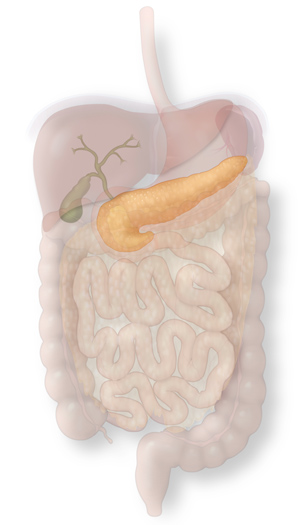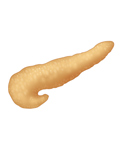The pancreas and its role in digestion and sugar control
 The pancreas is a gland that is a part of the digestive system as well as a hormone system that regulates sugar called the endocrine system. It is an oblong shaped organ that lies partially between the stomach and the spine with the other part being nestled in the curve of the duodenum.
The pancreas is a gland that is a part of the digestive system as well as a hormone system that regulates sugar called the endocrine system. It is an oblong shaped organ that lies partially between the stomach and the spine with the other part being nestled in the curve of the duodenum.
The pancreas performs a number of functions which can be broadly divided into endocrine and exocrine functions. Endocrine has to do with hormones mainly dealing with regulating blood sugar and diabetes. Exocrine is more about the digestive function of the pancreas and the enzymes in pancreatic juice.
Pancreatic juice and digestion
Pancreatic juice contains enzymes for digesting the major types of food, protein, carbohydrates and fats. Pancreatic juice can be simplified to be thought of as digestive juice that helps break down fat and proteins so that they can be absorbed in the other parts of the intestines. This juice is made by cells that produce enzymes called acinar cells.
Although bile salts and the liver are important in fat digestion, the most important enzyme for the digestion of fats (triglycerides) is the pancreatic lipase that is found in pancreatic juice. While most of the protein digestion occurs in the duodenum and jejunum, when proteins leave the stomach they aren't ready yet to be absorbed by other parts of the small intestine. Pancreatic enzymes help break down proteins into smaller pieces. Some of the enzymes in pancreatic juice also help neutralize stomach acids before they enter the small intestine.
Endocrine function and how the pancreas helps control sugar
The endocrine functions are carried out by cell clusters that are collectively called Islets of Langerhans. These islets have four main cell types. These cell types produce different hormones that help balance sugar levels in the blood. The hormone glucagon helps increase the level of blood sugar – also called glucose. Insulin helps decrease levels of blood sugar by helping the body's cells absorb and use the glucose that is circulating in the blood. Other hormones include somatostatin which balances the interaction between glucagon and insulin. The pancreas also produces pancreatic polypeptide which also helps regulate other secretions.
Anatomy of the pancreas
The pancreas is divided into five parts:
- Head – The pancreas is widest at the head which rests in the curve of the duodenum.
- Body – This is the central part of the gland and lies behind the stomach.
- Tail – It lies touching the spleen on the left side of the abdomen.
- Neck – The narrow portion that lies between the head and the body.
- Uncinate Process – This is the portion of the pancreas that lies underneath the body of the pancreas.
There is a long pancreatic duct which is present across the entire length of this organ. This duct carries pancreatic fluid from the pancreas to the duodenum and inserts very close to where the duct from the liver and the gallbladder insert into the duodenum as well.
Common disorders of the pancreas
The two main conditions that affect the pancreas are pancreatitis and pancreatic cancer.
Pancreatitis
Pancreatitis is a condition in which the pancreas gets inflamed; it can be either an acute or a chronic condition. In both cases, the subject can experience severe pain in the abdomen.
Pancreatitis can be a very dangerous condition because of the digestive juice of the pancreas and its normal role in digestion. When the pancreas becomes damaged, the enzymes that typically digest fat and meat inside the intestines, can leak out and enter the abdominal cavity. This means that the juices of the pancreas can actually start to digest internal organs and cause extensive damage.
There are many causes of pancreatitis. A common cause of pancreatitis is a condition where a stone from your gallbladder travels out of the gallbladder bile tube and enters the main duct. This may irritate the pancreas as it travels and sometimes cause severe pancreatitis. The risk of gallstone pancreatitis is another reason why laparoscopic cholecystectomy is recommended in patients with symptomatic gallstones.
Alcohol also has a toxic effect on the pancreas therefore alcoholics can suffer from pancreatitis that has nothing to do with gallstones. Genetics and nutrition are also factors that can instigate the onset of pancreatitis. Nausea, vomiting, fever, abdominal pain, and jaundice (when the skin turns yellow) are some of the symptoms of pancreatitis.
Pancreatic Cancer
Pancreatic cancer is one of the leading causes of cancer-related deaths in America. Complete remission is a rare occurrence. The majority of the tumors occur in the exocrine cells. Risk factors for pancreatic cancer include old age, gender, diabetes, alcohol, obesity, and possibly a diet poor in fruits and vegetables.
One of the fallouts of having the pancreas so deeply embedded is that any abnormal growths cannot be felt by touch; this is the reason why pancreatic cancers are often diagnosed only when they grow large enough to impinge on the functioning of surrounding organs.

